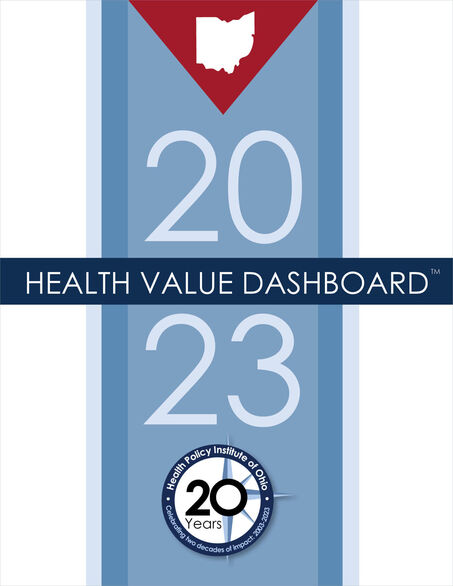2023 Health Value Dashboard™
The biennial Health Value Dashboard is a tool to track Ohio’s progress toward health value — a composite measure of Ohio’s performance on population health outcomes and healthcare spending. The Dashboard examines Ohio’s performance relative to other states and D.C., tracks change over time, identifies and explores health disparities and inequities in Ohio, highlighting evidence-informed strategies that can be implemented to improve Ohio’s performance.
Downloads:
- Facts & Figures (PowerPoint with data graphics from the report for public use)
- Frequently Asked Questions (FAQ) about the Dashboard
Where does Ohio rank?
- Ohio ranks 44 out of 50 states and the District of Columbia (D.C.) on health value. This means that Ohioans are living less healthy lives and spending more on health care than people in most other states.
- Ohio ranks in the bottom quartile on 28.3% of ranked metrics and in the top quartile on 8.5% of ranked metrics.
How can Ohio improve?
Ohio policymakers have many options to build on Ohio’s assets to create opportunities for prosperity and well-being throughout the state.
- Strengthen Ohio's workforce. Ohio can build upon recent success in attracting employers in high-growth industries to strengthen the workforce and reduce poverty
- Foster mental well-being. Ohio can build upon expertise with, and community response to, the addiction crisis to become a national leader in behavioral health
- Improve healthcare effectiveness. Ohio can build upon strengths in access to care to reinvigorate approaches to improving outcomes and controlling healthcare spending
More progress needed to reduce tobacco use
Reducing tobacco use and nicotine dependence is a powerful way to improve health, advance health equity and reduce healthcare spending.
- While adult smoking rates decreased in Ohio from 2019 to 2021, the pace of improvement has been slower than in the U.S. overall.
- Tobacco use is one of the key factors contributing to Ohio’s poor performance on the Health Value Dashboard. Ohio’s persistently poor rank on the adult smoking metric (44th in this edition) helps to explain why the state struggles to improve health and control spending relative to other states.
Addressing the links between smoking, trauma and poverty is critical to make further progress.
- Trauma and toxic stress contribute to higher smoking rates among adults who have low incomes, have experienced childhood adversity and/or have poor mental health.
- HPIO analysis found that 33% of smoking in Ohio is attributable to adverse childhood experiences (ACEs). This means that doing more to prevent harms such as child maltreatment would lead to less smoking, saving an estimated $2.2 billion dollars in tobacco-related healthcare costs each year. • Tailored cessation services are also needed for people who face extra challenges to quitting, such as people with mental illness.
By:
Hailey Akah, JD, MA
Nick Wiselogel, MA
Carrie Almasi, MPA
Amy Bush Stevens, MSW, MPH
Lexi Chirakos, PhD
Published On
April 28, 2023
Table of Contents
 Download Publication
Download Publication
